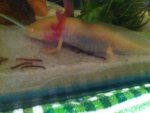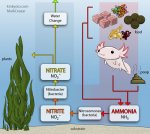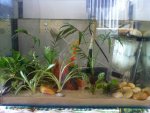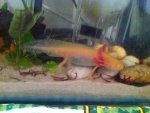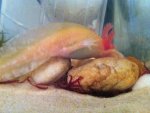I have my axies in their container (they've been fed and I've redone the water) and I've done a full water change, I've conditioned the water and now I have the filters on. I have sand substrate with a little "rock bed", about 9 plants(one on drift wood) and a little half dome hide that they love

i figured out today that I have approx. 37 litre tank but I don't know the water readings because I'm still waiting on my test kit

I'm really concerned about leaving them in the container though because I don't think they like it and they seemed happy in the tank so I'm confused

The reason for keeping them in a container is that it is easier to keep the water fresh and safe in the container while the tank cycles.
Axolotls excrete ammonia and their poop decays into ammonia and other nasty stuff. Once your tank is cycled, the bacteria can convert the ammonia into nitrite then into nitrate, which isn't as toxic. Have you started reading the links on "the cycle" yet? :happy:
Yes, you can keep them in the tank, but then you have to keep doing big water changes to keep the ammonia low enough to be safe. It is much easier to keep them in a smaller container and do frequent total water changes and just let the tank cycle.
If you cannot keep them in containers safely (like, cats or children that you can't keep away from the containers), then you should keep them in the tank, but you need to be very careful to keep an eye on ammonia and nitrite.
In an ideal world, everyone would cycle their tanks before getting an axolotl (or fish) but very few pet stores tell people that option, much less recommend it.
Meanwhile, the tank ... 1. I suspect some of those rocks are too small for a full-grown axolotl, so keep an eye on that as they grow. You want rocks bigger than their head. 2. If it is 37 L, you will need a bigger tank before they are full-grown. For two axolotls, a 110 L is a good size.
 I've been feeding them blood worms out of their tank so they don't eat the sand. They have lots of plants and some rocks to chill on, they seem happy but I worry about him/her
I've been feeding them blood worms out of their tank so they don't eat the sand. They have lots of plants and some rocks to chill on, they seem happy but I worry about him/her 




